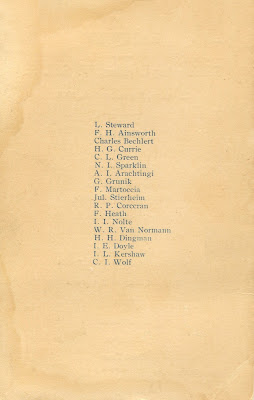In 1905, eleven of the inspectors had also attended the previous year’s outing. Among them was Luther C. Steward, perhaps the highest-ranking federal employee on the list, who was appointed acting commissioner of the Angel Island Immigration Station in San Francisco Bay when it officially opened in 1910. Steward was known as a compassionate professional, submitting reports critical of the facility’s physical layout and unsanitary conditions. In stark contrast, the second name on the list, Frank H. Ainsworth, authored a 1904 report titled “Burdens of Recent Immigration” for the Immigration Restriction League, a nativist organization that sought to limit immigration through literacy tests. Captain Ainsworth was later transferred to Angel Island, where he actively opposed South Asian immigration until about 1915, when he was dismissed for theft and “misconduct in office.”
Tuesday, May 9, 2023
Where the Immigration Inspectors Dined
New York City,
The Ellis Island immigration station reopened in 1900 after a devastating fire three years earlier. By 1902, operations had undergone significant changes, including the posting of “Kindness and Consideration” signs to remind inspectors, interpreters, doctors, nurses, and social workers to treat immigrants respectfully. Between 1900 and 1918, ten million people entered the United States through Ellis Island. Unlike the 19th century, when most immigrants came from northern and western Europe, the early 20th century saw a surge from eastern Europe, czarist Russia, and southern Italy. Menus from staff outings in 1904 and 1905 featured dishes reflecting the cuisines of these newcomers—though this should not be taken to mean that all employees supported the immigration laws of the era.
In 1905, the inspectors attended a three-act musical comedy titled “Fontana” at the Lyric Theatre on West 42nd Street. Later that evening, they dined at Moretti, an Italian restaurant on West 35th Street, near Sixth Avenue.2 The restaurant's name appears in quotation marks, perhaps reflecting the retirement of Stefano Moretti, who returned to Italy in 1903 after running his eponymous restaurant for over forty years. The set menu below, featuring the house pasta dish, would have cost about 65 cents.
In 1905, eleven of the inspectors had also attended the previous year’s outing. Among them was Luther C. Steward, perhaps the highest-ranking federal employee on the list, who was appointed acting commissioner of the Angel Island Immigration Station in San Francisco Bay when it officially opened in 1910. Steward was known as a compassionate professional, submitting reports critical of the facility’s physical layout and unsanitary conditions. In stark contrast, the second name on the list, Frank H. Ainsworth, authored a 1904 report titled “Burdens of Recent Immigration” for the Immigration Restriction League, a nativist organization that sought to limit immigration through literacy tests. Captain Ainsworth was later transferred to Angel Island, where he actively opposed South Asian immigration until about 1915, when he was dismissed for theft and “misconduct in office.”
1904-1905
In 1904, eighteen inspectors dined at the Café Boulevard on Second Avenue at East 10th Street.1 The fashionable Hungarian restaurant featured an orchestra, red marble dining room, and a graceful circular staircase that “seemed to float in air,” according to the New York Times. A 1903 guidebook titled Where and How to Dine in New York rhapsodized over its paprika chicken, a signature dish that appears on this menu. The names of the attendees are shown on back of the card.
In 1905, eleven of the inspectors had also attended the previous year’s outing. Among them was Luther C. Steward, perhaps the highest-ranking federal employee on the list, who was appointed acting commissioner of the Angel Island Immigration Station in San Francisco Bay when it officially opened in 1910. Steward was known as a compassionate professional, submitting reports critical of the facility’s physical layout and unsanitary conditions. In stark contrast, the second name on the list, Frank H. Ainsworth, authored a 1904 report titled “Burdens of Recent Immigration” for the Immigration Restriction League, a nativist organization that sought to limit immigration through literacy tests. Captain Ainsworth was later transferred to Angel Island, where he actively opposed South Asian immigration until about 1915, when he was dismissed for theft and “misconduct in office.”
Notes:
1. Theodore Roosevelt was said to be a regular visitor and attended a dinner in his honor there. In 1901, The Atlanta Constitution reported that the Café Boulevard was “popular with a certain Bohemian set who sits for hours over their dinners enjoying the well-cooked meal and the delicious, often high class, music.” In March 1904, Town & Country magazine noted that “in a short time the place became renowned.”
2. Moretti's moved several times during the second half of the nineteenth century, following its customers as they moved uptown. Its successive locations included ones on Cedar Street in lower Manhattan, East 14th Street, near Tammany Hall and the Academy of Music (and its Italian opera singers), and West 21st Street.
Subscribe to:
Post Comments (Atom)

















5 comments:
Fascinating!
So interesting. I wonder if current authorities overseeing the Mexican border have banquets.
Very interesting. Thank you! The menus are fabulous as always!
Great article. Looking into this further, I learned that Ainsworth was dismissed from his position as inspector around 1915, after an investigation found him guilty of “misconduct in office” and “accepting supplies for his family from the Angel Island supply station”.
Angel Island officers were notoriously cruel to Asian immigrants. Some languished in holding pens for years. I wonder if this fellow hadanything to do with that situation.
Post a Comment